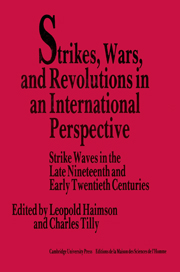 Strikes, Wars, and Revolutions in an International Perspective
Strikes, Wars, and Revolutions in an International Perspective Published online by Cambridge University Press: 25 March 2010
Germany has never been the classic country for researching labor conflicts and least of all for researching strike action by quantitative methods. Thus, only a few studies on the subject have been published. The time that has been best studied in the context of economic cycles and labor conflicts is the period before 1914. The findings fit well into the international context, for they confirm the impressive dependence of strike frequencies on economic cycles. A closer look, however, shows some problems in interpreting the results. These problems have to do with the choice of comparative indicators.
First of all, with regard to strike indicators, the fact that they oscillate between greater extremes than the series of economic cycle indicators is of importance. Thus, it is not a comparison of absolute figures that is required but one of the relative decline and increase, that is, a study of their relative changes.
Further, it is significant that positive results only arise if the number of strikes (and lockouts) is compared with economic cycle indicators, rather than the number of people involved. Therefore, Perrot's observation on France applies here: The economic cycle is the strongest influence on the decision to take strike action but all other questions, such as the form of participation, organization, duration, regional and branch involvement, depend on national or other factors. This statement becomes even more important because it is apparently valid regardless of trade union influence on a strike. Also, it applies especially to those times that were still characterized by very weak union movements (France and Germany before 1885).
To save this book to your Kindle, first ensure [email protected] is added to your Approved Personal Document E-mail List under your Personal Document Settings on the Manage Your Content and Devices page of your Amazon account. Then enter the ‘name’ part of your Kindle email address below. Find out more about saving to your Kindle.
Note you can select to save to either the @free.kindle.com or @kindle.com variations. ‘@free.kindle.com’ emails are free but can only be saved to your device when it is connected to wi-fi. ‘@kindle.com’ emails can be delivered even when you are not connected to wi-fi, but note that service fees apply.
Find out more about the Kindle Personal Document Service.
To save content items to your account, please confirm that you agree to abide by our usage policies. If this is the first time you use this feature, you will be asked to authorise Cambridge Core to connect with your account. Find out more about saving content to Dropbox.
To save content items to your account, please confirm that you agree to abide by our usage policies. If this is the first time you use this feature, you will be asked to authorise Cambridge Core to connect with your account. Find out more about saving content to Google Drive.